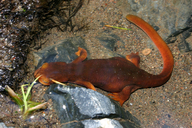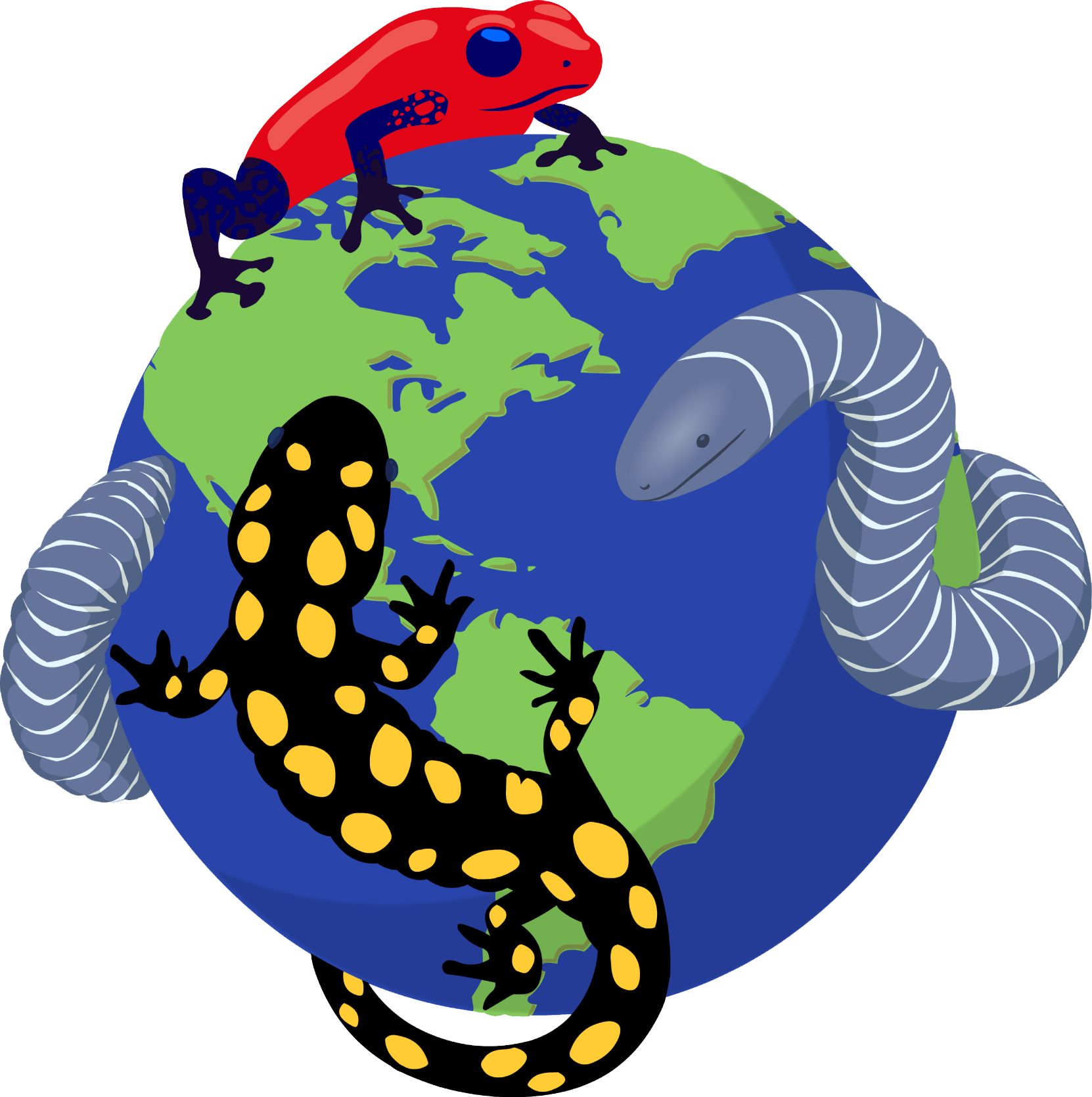|
Taricha sierrae (Twitty, 1942)
Sierra Newt Subgenus: Taricha | family: Salamandridae subfamily: Pleurodelinae genus: Taricha |
| Species Description: Kuchta SR 2007 Contact zones and species limits: hybridization between lineages of the California Newt, Taricha torosa, in the southern Sierra Nevada. Herpetologica 63:332-350. | |
 © 2018 William Flaxington (1 of 46) |
|
|
|
Description During the breeding season, males have a smooth skin, an enlarged and laterally flattened tail to swim better, a lighter body color, enlarged cloacal glands, enlarged mental glands, and tiny cornified papillae on the toe tips and hindlimb bases (to aid in grasping females during amplexus) (Petranka 1998). Hatchlings are light yellow dorsally with two irregular dark, narrow bands on the back (Twitty 1942). Taricha sierrae has dark spots or blotches along the sides of its body, which are more prominent in older larvae. Hatchlings reach 13-14 mm TL (Riemer 1958). Distribution and Habitat Country distribution from AmphibiaWeb's database: United States U.S. state distribution from AmphibiaWeb's database: California
Taricha sierrae is one of two species of newts present in the Sierra Nevada of California, the other being Taricha granulosa, the Northern Rough-skinned newt. The Sierra newt ranges along the western slopes of the Sierra Nevada with drainage from Sacramento to San Joaquin Rivers, Tulare Lake (Jennings 1996). Adult T. sierrae inhabit a variety of usually terrestrial habitats, becoming aquatic when breeding. They mostly inhabit foothills dominated by conifers, especially gray pine-blue oak and ponderosa pine communities (Petranka 1998). During the summer, the Sierra newt prefers moist habitats under woody debris or in animal burrows. Adults generally breed in relatively swift-flowing streams, but will sometimes use still water, including farm ponds, lakes, or ditches (Petranka 1998). Life History, Abundance, Activity, and Special Behaviors Adults typically require 6-8 weeks to reach breeding sites and both sexes breed every other year. Males arrive at breeding sites before females and stay longer after breeding (Twitty 1942). There are more males than females at breeding sites and males must compete for a mate. When courting, the male amplexes the female and, after about an hour of intermittent periods of head rubbing and tail fluttering, the male dismounts and deposits a spermatophore. The female picks up the spermatophore with her cloaca. Quickly after mating, females attach spherical masses of 11-22 eggs to the sides and bottoms of stones in fairly fast-flowing stream water. Taricha sierrae tend not to oviposit in cryptic sites, since exposed egg masses could be washed from rocks in the faster-flowing water. Total clutch size is not known. The mean egg diameter is 2.8 mm, while the jelly layers surrounding the eggs swell within hours to form a firm mass measuring 15-25 mm in diameter (Petranka 1998). Incubation may last from 14-52 days, depending on local water temperatures, population, and other factors (Storer 1925; Mosher et al. 1964; Petranka 1998). After a larval period of a few months, transformation occurs in late summer or early autumn (Riemer 1958). Larvae usually transform at 55-62 mm TL beginning in late August (Petranka 1998). Sierra and California newts (T. sierrae and T. torosa) have a diet consisting mostly of worms, snails, eggs, larvae, insects, sowbugs, slugs, and other invertebrates, but may opportunistically take other prey, such as larval newts. A hatchling bird was even found in the stomach of one adult T. torosa. Adults feed when in breeding streams and T. torosa often cannibalize their own eggs and larvae. T. torosa females cannibalize eggs more often than males, sometimes as soon as the eggs protrude from another female's vent (Petranka 1998). After transformation, juveniles leave the water for surrounding habitats, and the juvenile stage likely lasts 5-8 years. Adults spend the dry summer months in moist, subsurface habitats, and emerge with the onset of autumn rains. Adults are more active on the ground surface than juveniles. Adults may make clicking sounds when they encounter other newts, sometimes accompanied by rising high on the legs and wagging the tail. Another defensive pose, known as the "unken" reflex, is to assume a swaybacked position with the tail tip held straight out, exposing the bright ventral surface (in contrast to the defensive posture of T. granulosa, where the tail tip is curled). This posture can be induced by tapping newts on their bodies. Sierra newts will sometimes squeak when picked up (Petranka 1998). However, their main defense against predators is the potent neurotoxin, tetrodotoxin, present in the Sierra newt's skin, ova, and ovaries (Buchwald et al. 1964). Trends and Threats Comments This species was featured as News of the Week on 2 August 2021: Most amphibians secrete distasteful or toxic substances from their skin. Several groups wield toxins that can be lethal to other animals, or even to themselves. Animals can evolve resistance to toxins through mutations in proteins that prevent toxins from binding. Although these mutations can provide resistance, they often occur in important regions of a protein, such as those critical to nervous system functions. Thus, a problem arises: how can animals avoid the negative effects of mutations that also provide resistance? A pair of recent studies, one on the toxic salamanders Taricha (Gendreau et al. 2021) and another on frogs of the genus Leptodactylus (Mohammadi et al. 2021), which consume toxic toads, suggest that gene duplication is the key; one gene copy can help animals develop toxin resistance while the other copy maintains a functional nervous system. Both studies also show evidence for a fascinating molecular process known as gene conversion, wherein duplicate copies of one gene retain more similar-than-expected DNA sequences. During homologous recombination, two copies of a genome line up and exchange pieces of DNA; however, when two copies of a gene are near each other in the genome, the wrong genes can line up and exchange genetic material, maintaining genetic similarity between duplicate copies of a gene. In newts, gene conversion appears to have copied resistance-conferring mutations from one gene domain to another. In Leptodactylus frogs, strong natural selection countered the force of gene conversion, resulting in one toxin-resistant gene and one toxin-sensitive gene. How newts and frogs regulate the use of these different gene copies remains unknown and will be an exciting future research topic. (RT)
References
Buchwald, H. D., Durham, L., Fischer, H. G., Harada, R., Mosher, H. S., Kao, C. Y., and Fuhrman, F. A. (1964). ''Identity of tarichatoxin and tetrodotoxin.'' Science, 143, 474-475. Jennings, W.B. (1996). ''Status of amphibians.'' Sierra Nevada Ecosystem Project, Final Report to Congress. Center for Water and Wildland Resources, University of California (Davis), Davis, California, 921-944. Kuchta, S. R. (2007). ''Contact zones and species limits: hybridization between lineages of the California Newt, Taricha torosa, in the southern Sierra Nevada.'' Herpetologica, 63, 332-350. Liss, W. J., and Larson, G. L. (1991). ''Ecological effects of stocked trout on North Cascades naturally fishless lakes.'' Park Science, 11, 22-23. Mosher, H. S., Fuhrman, F. A., Buchwald, H. D., and Fischer, H. G. (1964). ''Tarichatoxin-tetrodotoxin: a potent neurotoxin.'' Science, 144, 1100-1110. Petranka, J. W. (1998). Salamanders of the United States and Canada. Smithsonian Institution Press, Washington D.C. and London. Riemer, W. J. (1958). ''Variation and systematic relationships within the salamander genus Taricha.'' University of California Publications in Zoology, 56, 301-390. Stebbins, R.C. (1951). Amphibians of Western North America. University of California Press, Berkeley. Storer, T. I. (1925). "A synopsis of the amphibia of California." University of California Publications in Zoology, 27, 1-342. Twitty, V. C. (1942). ''The species of Californian Triturus.'' Copeia, 1942, 65-76. Originally submitted by: Amy Ru Chen (first posted 2008-05-13) Edited by: Amy Ru Chen, Reference Changed by Ann T. Chang (2021-08-02) Species Account Citation: AmphibiaWeb 2021 Taricha sierrae: Sierra Newt <https://amphibiaweb.org/species/6967> University of California, Berkeley, CA, USA. Accessed Nov 21, 2024.
Feedback or comments about this page.
Citation: AmphibiaWeb. 2024. <https://amphibiaweb.org> University of California, Berkeley, CA, USA. Accessed 21 Nov 2024. AmphibiaWeb's policy on data use. |




 Map of Life
Map of Life